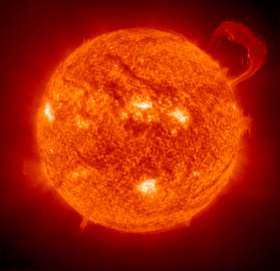Solar Flare
Solar flares are sudden blasts of electromagnetic radiation and charged particles emanating from the surface of the Sun. They are distinct from the everyday solar wind due their association with highly energetic eruptions.

Solar outbursts roughly follow an 11-year cycle of maximum and minimum activity, although the cycle time period has been known to vary from 8 to 15 years. (A magnetic polarity flip between northern and southern sunspots means one complete cycle is actually 22 years.) Part of this activity is the enhanced prominence of sunspots: dark cool regions on the Sun that are a mere 3,000 C, compared to the average 6,000 C surface temperature. These cooler sunspot regions exist because, in certain areas on the Sun’s surface, it’s magnetic field inhibits the escape of heat from the interior, trapping the hot gas beneath the surface and producing the relatively cool sunspots. The (internal) rotation and thus dynamo which powers the magnetic fields in the Sun is ultimately responsible for the solar outbursts. When plasma bubbles up through the convection zone it can for a time be confined by the local magnetic fields on the Sun. However, the combined effect of the Sun’s rotation and internal dynamics often leads to a region of hot plasma bubbling up and breaking free, shooting out vast quantities of high speed particles as a solar flare. Flares can be tens of thousands of kilometres across and arise on a time scale of tens of minutes to hours.
Solar flares emit large quantities of UV and X-ray radiation which, after some 8 minutes travel time to Earth, can cause a sudden increase in the density of ionized particles in the lower D- and E- regions of the sunlit side of the Earth’s ionosphere. Such disturbances last from minutes to hours, corresponding to the lifetime of the flare. The slower moving plasma, a soup of primarily electrons and protons, takes at least several hours to a few days to reach Earth.
Depending on the amount of energy released, or more specifically the intensity, over the X-ray wavelength range from 1 to 8 Angstroms, a flare may be either an A, B (< 10-6 W/m2), C (10-6 – 10-5 W/m2), M (10-5 – 10-4 W/m2) or X (> 10-4 W/m2) class flare. When directed at Earth, X class flares can cause serious problems, with the ensuing geomagnetic storm resulting in radio blackouts and even the loss of satellites. The energy of such eruptions is millions of times greater than that from an erupting volcano or a hydrogen bomb.
Study Astronomy Online at Swinburne University
All material is © Swinburne University of Technology except where indicated.

